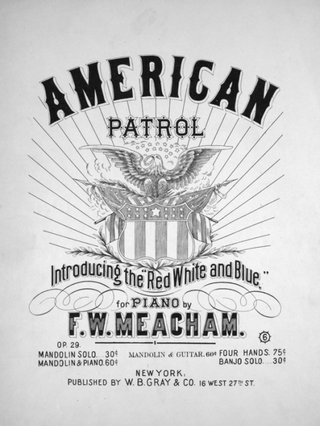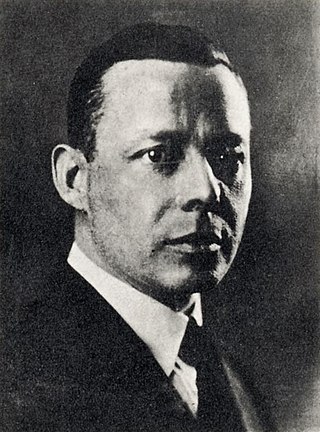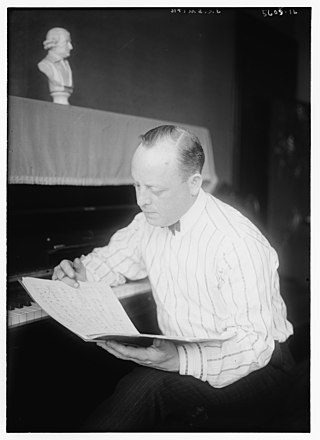
American march music is march music written and/or performed in the United States. Its origins are those of European composers borrowing from the military music of the Ottoman Empire in place there from the 16th century. The American genre developed after the British model during the colonial and Revolutionary periods, then later as military ceremonials and for civilian entertainment events.
The 5th Annual Grammy Awards were held on May 15, 1963, at Chicago, Los Angeles and New York City. They recognized accomplishments by musicians for the year 1962. Tony Bennett and Igor Stravinsky each won 3 awards.

A concert band, also called a wind band, wind ensemble, wind symphony, wind orchestra, symphonic band, the symphonic winds, or symphonic wind ensemble, is a performing ensemble consisting of members of the woodwind, brass, and percussion families of instruments, and occasionally including the harp, double bass, or bass guitar. On rare occasions, additional, non-traditional instruments may be added to such ensembles such as piano, synthesizer, or electric guitar.

Frederick Fennell was an American conductor and one of the primary figures which promoted the Eastman Wind Ensemble as a performing group. He was also influential as a band pedagogue, and greatly affected the field of music education in the US and abroad. In Fennell's New York Times obituary, colleague Jerry F. Junkin was quoted as saying "He was arguably the most famous band conductor since John Philip Sousa."
The Eastman Wind Ensemble was founded by conductor Frederick Fennell at the Eastman School of Music in 1952. The ensemble is often credited with helping redefine the performance of wind band music. Considered one of America's leading wind ensembles, its core personnel of 50 players consists of undergraduate and graduate students at the Eastman School of Music.

The Rochester Philharmonic Orchestra (RPO) is an American orchestra based in the city of Rochester, New York. Its primary concert venue is the Eastman Theatre at the Eastman School of Music.

Claudio S. Grafulla (1812–1880) was a composer in the United States during the 19th Century, most noted for martial music for regimental bands during the early days of the American Civil War.

"National Emblem", also known as the National Emblem March, is a U.S. march composed in 1902 and published in 1906 by Edwin Eugene Bagley. It is a standard of the U.S. march repertoire, appearing in eleven published editions. The U.S. military uses the trio section as ceremonial music for the entry of the ceremony's official party.

"American Patrol" is a popular march written by Frank White (F.W.) Meacham in 1885. It incorporates both original musical themes by Meacham and melodies from American patriotic songs of the era such as "Columbia, the Gem of the Ocean," "Dixie," and "Yankee Doodle." Composed for piano, it was then arranged for wind band and published by Carl Fischer in 1891. Copyright was assigned to Meacham's widow, Cora, in 1912 and renewed in 1919. The 1885 and 1914 printings for piano do not include "Dixie."
The Tokyo Kosei Wind Orchestra is a professional concert band based in Tokyo, Japan. TKWO has been called Japan's premiere wind ensemble, one of the most influential Japanese wind bands, and one of the world's leading professional civilian wind bands.

The 7th Regiment of the New York Militia, aka the "Silk Stocking" regiment, was an infantry regiment in the Union Army during the American Civil War. Also known as the "Blue-Bloods" due to the disproportionate number of its members who were part of New York City's social elite, the 7th Militia was a pre-war New York Militia unit that was mustered into federal service for the Civil War.

Joseph Charles Rosario Bourdon was a French Canadian cellist, violinist, conductor, arranger and composer. He was a child prodigy skilled with many musical instruments. Bourdon worked much of his life for the Victor Talking Machine Company where he exerted considerable influence.

"The High School Cadets" is a march written in 1890 by John Philip Sousa in honor of the cadet drill team of Washington High School in the District of Columbia. It is in regimental march form (I-AA-BB-CC-DD) and is a popular selection for school concert and marching bands, as well as for professional orchestras and bands. The march has been arranged for a wide variety of instruments and ensembles, and has been frequently recorded, including at least two recorded performances by Sousa's own band. The march's final strains were featured in the 1939 film The Under-Pup.

Colonial Song is a musical composition written by Australian composer Percy Grainger. Although Grainger created versions for different types of musical ensembles, its most commonly used version today is for concert band.

Bohumir Kryl was a Czech-American financial executive and art collector who is most famous as a cornetist, bandleader, and pioneer recording artist, for both his solo work and as a leader of popular and Bohemian bands. He was one of the major creative figures in the era of American music known as the "Golden Age of the Bands".
Walter Bowman Rogers was an American cornet player, concert band and orchestral conductor and composer, who was responsible for most of the orchestral arrangements on recordings made for the Victor Talking Machine Company between 1904 and 1916. He left the Victor Company when he accepted an equity partnership with the Paroquette recording company, a venture which ended when the company went into receivership. He accepted arranging, conducting positions with the Paramount and Emerson companies before he was offered an executive-level position by the Brunswick-Balke-Collander Company when the nationally known manufacturer of bowling, saloon, and phonograph cabinetry decided to expand its operations in the talking-machine industry by creating a line of phonograph recordings. Rogers became Brunswick’s director of classical-music releases, a role he held until shortly before the Brunswick phonograph division was acquired by the Warner Brothers film corporation in April 1930.
Frank Bencriscutto, nicknamed "Dr. Ben," was an American conductor and composer of concert band music. Bencriscutto was Director of Bands and Professor of Music at the University of Minnesota for thirty-two years.

Joseph C. Smith was an American violinist, composer, dance band leader and recording artist most popular in the second and third decades of the 20th century.
Newton Hart Wayland was an American orchestral conductor, arranger, composer and keyboardist. The product of an elite musical education, Wayland was known for his dedication to performing for the broadest possible audience.

Charles Delaware Staigers was an American cornetist. He was born on August 20, 1899, in Muncie, Indiana. In 1914, he was hired to play in Patrick Conway's band. In 1918, he joined John Philip Sousa's band as the assistant to cornet soloist Frank Simon. He stayed with John Philip Sousa through 1920. He played "Taps" at John Philip Sousa's funeral. After leaving Sousa, he became first trumpeter at The Hippodrome and later at The Strand Theatre in New York City. In 1926, he joined the Goldman Band. His first appearance with The Goldman Band in Central Park before a crowd of over 25,000 people drew vociferous applause and bravos. He played with The Goldman Band through 1934, and also for the 1942 season.














